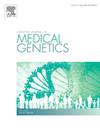868例神经发育障碍患儿临床外显子组测序的诊断率
IF 1.7
4区 医学
Q3 GENETICS & HEREDITY
引用次数: 0
摘要
下一代测序已经彻底改变了神经发育障碍(ndd)患者的诊断方法,然而,根据患者的表型,产量变化很大。预测哪些适应症可能导致分子诊断,哪些从基因检测中获益较少,往往具有挑战性。为了确定与更高诊断率相关的表型特征,我们对868名患有NDD的儿童进行了详细的表型分析,这些儿童在2016年至2021年间进行了临床外显子组测序。分子诊断达到27%的病例。智力残疾(ID)和全面发育迟缓(GDD)患者的产率分别为34%和32%。自闭症谱系障碍(ASD)不太可能导致分子诊断,诊断率为16%。与高产量相关的其他因素包括女性、轻微畸形特征的存在——特别是涉及面部、四肢、耳朵、眼睛和头发——以及综合征表型。在438名同意重新分析测序数据的患者中增加CNV呼叫,使诊断率提高1.5%。本文章由计算机程序翻译,如有差异,请以英文原文为准。
Diagnostic yield of clinical exome sequencing in 868 children with neurodevelopmental disorders
Next generation sequencing has revolutionized the diagnostic approach for patients with neurodevelopmental disorders (NDDs), yields are however highly variable depending on the patient's phenotype. It is often challenging to predict which indications are likely to lead to a molecular diagnosis and which will benefit less from genetic testing.
To identify phenotypic characteristics associated with higher diagnostic yields we conducted detailed phenotyping of a cohort of 868 children with NDD, who underwent clinical exome sequencing between 2016 and 2021.
A molecular diagnosis was reached in 27 % of cases. Significantly higher yields of respectively 34 % and 32 % were observed in patients with intellectual disability (ID) or global developmental delay (GDD). Autism spectrum disorders (ASD) were less likely to result in a molecular diagnosis with a diagnostic yield of 16 %. Additional factors linked to higher yields included female gender, the presence of minor dysmorphic features — particularly involving the face, extremities, ears, eyes, and hair — and a syndromic phenotype.
Additional CNV calling in a subset of 438 patients which consented to reanalysis of sequencing data added 1.5 % to diagnostic yield.
求助全文
通过发布文献求助,成功后即可免费获取论文全文。
去求助
来源期刊
CiteScore
4.10
自引率
0.00%
发文量
193
审稿时长
66 days
期刊介绍:
The European Journal of Medical Genetics (EJMG) is a peer-reviewed journal that publishes articles in English on various aspects of human and medical genetics and of the genetics of experimental models.
Original clinical and experimental research articles, short clinical reports, review articles and letters to the editor are welcome on topics such as :
• Dysmorphology and syndrome delineation
• Molecular genetics and molecular cytogenetics of inherited disorders
• Clinical applications of genomics and nextgen sequencing technologies
• Syndromal cancer genetics
• Behavioral genetics
• Community genetics
• Fetal pathology and prenatal diagnosis
• Genetic counseling.

 求助内容:
求助内容: 应助结果提醒方式:
应助结果提醒方式:


